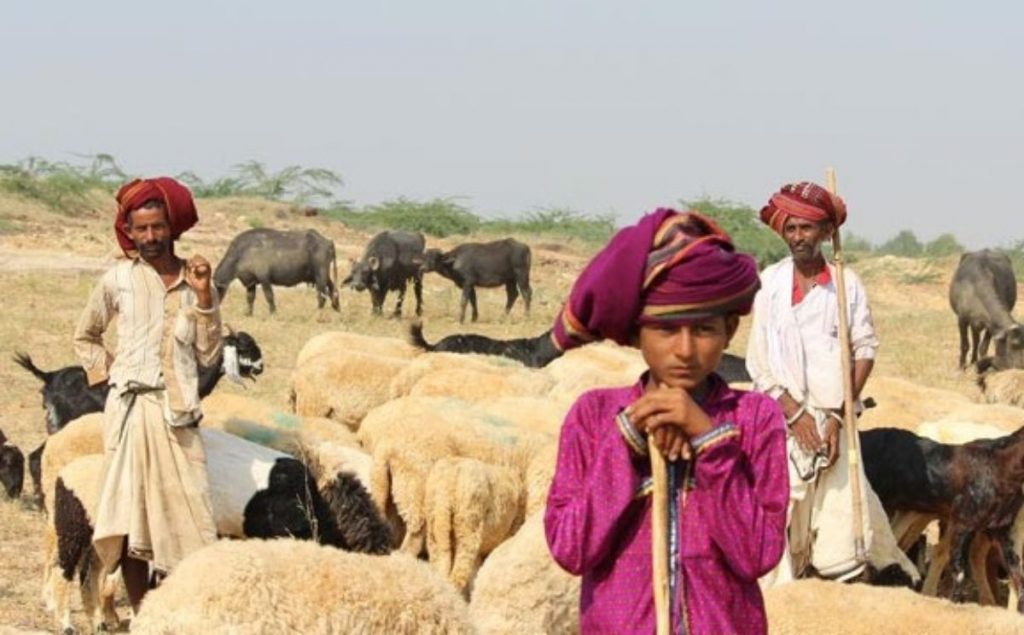Gujarat: Panel To Be Formed To Decide On Tribal Status Of 3 Communities
The commission, which will be headed by a retired judge of the high court, comprises two district judges, one retired forest officer and one retired revenue officer.
The Gujarat government on Wednesday said that a five-member commission will be formed to identify the members of Rabari, Bharvad and Charan communities, living in nesses (tiny, oval-shaped hutments made of mud) of Gir, Barda and Alech areas of the state, who are eligible to get the benefits of Schedule Tribe (ST) status.
The commission, which will be headed by a retired judge of the high court, comprises two district judges, one retired forest officer and one retired revenue officer.
The central government had, through a notification dated October 29, 1956, conferred ST status on people from Rabari, Bharvad and Charan communities living in the nesses of Gir, Barda and Alech in the state.
However, many tribal community leaders have been protesting for quite some time alleging that a number of people who do not live in nesses have managed to get ST certificates and are enjoying undue reservation benefits, mainly in government jobs. Leaders of Rabari, Bharvad and Charan communities have also held counter protests.
To resolve this issue and decide the legitimate beneficiaries of ST status among the members of the three communities, the commission has been formed. The decision was taken in the state Cabinet meeting headed by Chief Minister Vijay Rupani. Tribal Development Minister Ganpat Vasava made the decision public while saying that the commission was formed after three senior ministers of the Cabinet held a meeting with representatives from the tribal community and from Rabari, Bharvad and Charan communities.
Vasava said that while considering various representations, the state Cabinet has decided to form this commission to ensure that the tribals who are eligible for the benefits are not devoid of their right and the others do not get undue benefit. He said that representatives of both the parties had given their consent for the formation of the panel.
Why India Needs Scheduled Tribes to Educate its Future Judges
The rights of adivasis in the Indian constitution are not an act of benevolence to “mainstream and uplift them” but a recognition that the “mainstream” of Indian society has many streams that flow into it, each of them equally valid.
If 100% reservation for teaching jobs is not permissible, the next step will be for someone to argue against the ban on alienation of tribal land, or overturn the Samata judgment prohibiting mining leases being given to non-tribals in 5th Schedule Areas in undivided Andhra Pradesh. After all, both these ‘discriminate’ against non-tribals. As non-adivasis from other districts flood scheduled areas leading to clear demographic change, the clamour to do away with the protective provisions of the 5th Schedule is only getting louder.
The Andhra Pradesh G.O. of 2000 was aimed at promoting education in tribal areas and addressing the problem of rampant teacher absenteeism. As anyone even slightly acquainted with the problems of tribal areas knows, non-tribal teachers are often reluctant to travel to or live in remote adivasi hamlets. Another big problem is language. Many non-tribals, including lower government officials, have lived for years in tribal areas without feeling the need to learn tribal languages. At the primary level, mutual incomprehension between non-tribal teachers and tribal students hampers the basic education of children.
The judges tell us that “It is an obnoxious idea that tribals only should teach the tribals”, but for far too long, the really obnoxious idea that has pervaded the educational system and is reflected in judgments like this one is that only non-tribals should teach tribals, to “uplift and mainstream” them because “their language and their primitive way of life makes them unfit to put up with the mainstream and to be governed by the ordinary laws”
A standard view is that expressed by Justice S.B. Sinha in his (minority) judgment of the Andhra high court on the same issue in 2001, where non-tribal teachers are axiomatically assumed to be more efficient and meritorious ; and “(f)or upliftment of the educationally backward people, it is necessary to impart education through teachers who are more informed and more meritorious regardless of their caste”.
For the Supreme Court to say, “They are not supposed to be seen as a human zoo and source of enjoyment of primitive culture and for dance performances” betrays a mentality that thinks of Scheduled Tribes precisely in those terms rather than as people with the right to define their own educational future. For far too long, education in India has been seen by the establishment as a ‘civilising’ mission designed to make adivasis and dalits into mental clones of the upper castes, even if they continue in their subordinate jobs. Merit is defined merely as efficiency in achieving this goal, rather than in terms of success in tapping indigenous ecological knowledge, preserving adivasi languages and culture and giving confidence to adivasi students by acting as role models. Even though many adivasi teachers have also internalised this idea of non-tribal superiority, having hundred per cent adivasi teachers in Scheduled areas is a small step towards reversing this condescension.
The idea behind the order goes back to the educational experiments pursued by anthropologists and advisors to the Nizam’s government, Christoph Von Furer-Haimendorf and W.G. Grigson, and the efforts by concerned administrators like B.D. Sharma, S.R. Sankaran, B.N. Yugandhar and E.A.S. Sarma to provide a governmental alternative to the pull of the Naxalites. The legal defence of the government order, however, has fallen to the lot of the anthropologist J.P. Rao, along with adivasi teacher and leader Sondhi Veeriah, as well as lawyers like K. Balagopal and Rajeev Dhawan, who fought the case pro bono.
The Supreme Court judgment came in response to an appeal by non-tribals against the majority 2001 high court judgment, which upheld the G.O. of 2000. The Supreme Court verdict essentially replicates the minority view in the high court in favour of non-tribals.
The court framed four questions for itself: the first deals with the power of the governor in 5th Schedule areas to make laws, and whether this can override Part III of the constitution or fundamental rights; the second, whether 100% reservation is constitutionally permissible; the third, whether the GO involves a classification under Article 16 (1) dealing with equal access to state employment, rather than under 16 (4) which provides for reservation; the fourth, to do with the reasonableness of the eligibility requirement for reservation, i.e. continuous residence in the area since 1950. In answering each of the questions, sadly, the court shows itself unmindful of the realities of the country and the history of the constitution it has inherited.
The scope of the governor’s law-making powers
The court’s first argument in striking down the 100% reservation is that this was in effect a new law, since G.O. Ms. No. 3 of 2000 did not amend the Act dealing specifically with reservation, and rules did not count as an act of parliament or state legislature. Under Section 5 (1) of the 5th Schedule, the governor can only apply or decide not to apply laws that have been framed by the parliament or legislature, not make fresh law. On the same point, the majority judgment of the HC in Pulusam Krishna Murthy had held that “application of law is one of the recognised forms of legislation” and “it is illogical to hold that the same power does not extend to delegated legislation” ( of judgment by Justice V.V.S. Rao).
Whichever interpretation one chooses, it is important to remember that when the law-making power of the governor under the 5th Schedule was discussed in the constituent assembly’s Sub-Committee on Excluded and Partially Excluded Areas, the concern raised was not whether s/he could or should make fresh law, but that this power should not be used undemocratically, exercised over and above the elected legislature. It is for this reason that a Tribes Advisory Council was created and the governor was required to refer matters to it. ( sub-committee report). In this case, the Tribes Advisory Council had concurred with the 100% rule.
Fundamental rights vs Fifth Schedule?
On the question it posed to itself – of whether the legislative powers of the governor under Section 5 of the 5th Schedule could override fundamental rights – the Supreme Court answered in the negative.
On the face of it, who would quarrel with the proposition that any governor enacting a law or applying a law to Scheduled areas should be mindful of fundamental rights? For instance, one would hardly condone not applying a law on ‘witch’ killings because it was a ‘customary’ practice. But to argue that fundamental rights – and that too when interpreted narrowly as in this judgment as ‘equality’ for non-tribals– should always trump other parts of the constitution is to forget the way the constitution was crafted to allow for diversity-in-unity, whether Article 370 or its 5th and 6th Schedules.
Both fundamental rights and the 5th and 6th Schedules were intrinsic and coeval pre-conditions to the existence of the constituent assembly (CA). Clause 20 of the cabinet mission plan under which the CA functioned provided for an advisory committee to report on “the list of fundamental rights, the clauses for the protection of minorities, and a scheme for the administration of the tribal and excluded areas.” The rights of the Scheduled Tribes in the Indian constitution are not an act of benevolence to “mainstream and uplift them” but a recognition that the “mainstream” of Indian society has many streams that flow into it, each of them equally valid.
In the framework of the constitution, as Justice V.V.S. Rao noted in the majority judgment of the HC, there are several laws, including freedom of movement in Article 19 (5), whereby “the protection and interest of Scheduled Tribes would take precedence over the fundamental rights of the non-Scheduled Tribes.”
The Supreme Court makes much of the fact that G.O. of 2000 comes into direct conflict with a presidential order under Article 371 D which takes the district as the unit of recruitment and reservation for jobs. This order came into being since people from some districts of undivided Andhra were grabbing jobs everywhere. The court claims that since non-tribals cannot apply outside their district, and they are barred from Scheduled areas, they lose out on employment altogether. This is, unfortunately, an altogether specious conclusion since Scheduled areas form only a small portion of any district. For example, the Scheduled area in Visakapatnam district (the maximum in any district) is 52.9%, in Srikakulam it is 22.09% and in West Godavari (the lowest) it is 13%. Within these scheduled areas, the STs are in a clear majority and therefore deserve to have teachers from their own language communities – in Paderu/Visakapatnam, STs are 88% of the population, in Srikakulam 78% and in West Godavari, 47%. Outside the scheduled areas, only 6% of the posts are reserved for STs, 15 % for SCs, 25% for Backward Classes and 54 % (in effect) for the upper castes.
The minority HC judgment by Justice Sinha – now endorsed by the Supreme Court – also claimed that 100% reservation for ST teachers discriminated against non-ST students in Scheduled areas: “If a school is manned by the teachers of a particular class, the students belonging to the other classes would be discriminated against.” It is amazing how those who talk so feelingly about the need for a caste blind society and the problem of casteism only see themselves as victims of caste prejudices. They never consider the possibility that adivasi (and dalit) children taught by caste Hindus may be discriminated against.
Article 16 (1) or Article 16 (4)?
The majority bench of the high court in Pulusam was persuaded by the argument made by advocates K. Balagopal and others that the GO providing for 100% reservation was not made under 16 (4) which provides for reservations, but under 16 (1), which promises everyone an equal chance at state employment, and allows for reasonable classification in achieving this. Teaching posts in Scheduled areas, they argued, were a different category of jobs altogether – with different requirements and different objectives.
The SC, however, is categorical that reservation for Scheduled Tribes (as well as SCs and OBCs) is exhausted under 16 (4), and that 16 (1) is only for other classes not covered by 16 (4) though it is not clear who these other classes would be. In any case, we are told, without further explanation, “Assuming, for the sake of argument, it is to be a case of classification under Article 16(1), it would have been discriminatory and grossly arbitrary without rationale and violative of constitutional mandate.”
Original dwellers vs immigrants
Finally, we come to the fourth question which is at the heart of many contentious issues in the country today – how to balance the rights of immigrants and the rights of original dwellers. In the case of Assam, this has led to 19 lakh citizens being disenfranchised in the name of the updated National Register of Citizens; in Kashmir, however, the protection for domiciles embodied in Article 35 A was portrayed as illegitimate.
In the case of Scheduled Tribes, while commenting on the eligibility requirement for jobs, the Supreme Court does not appear to think the problem of demographic swamping by immigrants is an issue at all, nor does it concern itself with the rationale behind Scheduled areas in 1950: “The G.O. in question requires candidate or the parents to reside in the area continuously w.e.f. 26.1.1950 to date. There is no rhyme or reason to require continuous residence for last 50 years or more. It overlooks the rights of various other persons who might have settled decades together in the area in question… The same is fixed in highly unreasonable and arbitrary manner and limits zone of consideration to minuscule where an opportunity for public employment has to be afforded to all concerned with reasonable rights.”
Judging by the continued over-representation of Hindu upper castes in gainful employment in this country, one might well say that the same has come to be fixed in a “highly unreasonable and arbitrary manner” and there is no rhyme or reason to the upper caste Hindu conviction that it is only they who have the natural right to rule over, provide justice to, or teach in this country, and that children of all other castes and religions must be grateful for the education and justice they get.



